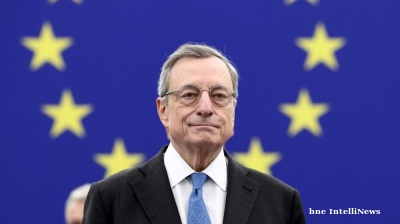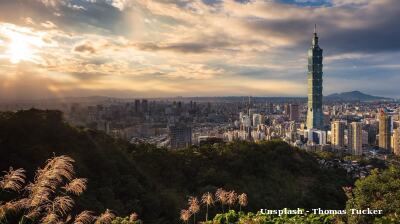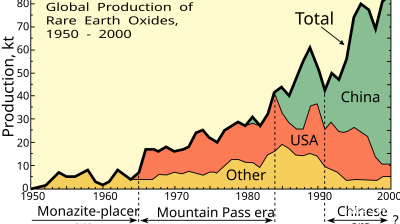Russia’s economy is booming. In the first quarter, Russian GDP grew by 5.4%, higher than in the fourth quarter of last year, albeit boosted by an extra day in February. The economy is on course to expand by over 3% this year or more, ahead of expectations.
The growth has gone beyond the military Keynesian boost Russia enjoyed in the first year of the war in Ukraine due to the torrent of military spending. A number of factors have come together to put the wind at the economy’s back as the changes in the economic growth become structural.
On the plus side of the balance sheet is higher than expected oil and gas revenues, as the West oil price sanctions have largely failed. Russia has also managed to almost entirely dodge the technology sanctions, with technology imports in 2023 only 2% less than a year earlier. Russian companies rallied to the challenge of sanctions and have been investing heavily in retooling their production lines to deal with the difficulties of obtaining Western inputs. Investments in fixed capital in Russia moved up by 14.5% year on year in the first quarter of 2024, RosStat recently reported to RUB5.93 trillion ($66.2bn) over the reported period. Fixed capital investments as of 2023 year-end gained 9.8% y/y and amounted to more than RUB34.04 trillion ($379.6bn).
The growth in industry shows up in Russia’s PMI manufacturing index, which was 54.4 in May, far ahead of the 50 no-change benchmark and one of the strongest expansions in Europe.
At the same time, the labour shortage – unemployment fell to a fresh all-time low of 2.6% in April – has driven nominal wages up about twice as fast as inflation (7.8% in April), which has seen real wages rise strongly for the first time in a decade and is fuelling a consumption boom. S&P Global reports that job creation in Russia in May was at its highest level in 26 years.
Another unintended side-effect of the war is that Russia's poorest regions have been the biggest winners from the militarisation of the Russian economy, and that has gone a long way to undoing Russia’s legendary income inequality, leading to a broader-based and more equitable growth in the whole country, not just the leading cities.
“Additional demand from the state was transferred to the population and business through government procurement, budget transfers and payments to households. The same processes spurred lending, including as a result of the improvement in the financial situation of borrowers: wages in March increased by 21.6% y/y in nominal terms and by 12.9% in real terms,” The Bell reports.
On the negative side of the balance sheet is that inflation remains stubbornly high and that the economy is running very hot, according to CBR Governor Elvira Nabiullina. The CBR’s forecast for the end of the year is that inflation will fall to 5.6% before returning to its target rate of 4% in 2025, but that is starting to look increasingly unlikely. However, the central bank has hiked rates to 16% and economists speculate that it may hike them again by as much 100bp in July in an effort to check inflation.
Another more worrying trend is that Russian productivity is falling, despite the record 81% capacity utilisation rate, as even with the government’s heavy investment into the military industrial complex Russian industry remains in desperate need of modernisation. However, this is on the agenda, as laid out in President Vladimir Putin’s recent guns and butter speech, and is at the heart of the National Projects 2.1, the Kremlin’s blueprint for developing the whole economy, not just the military industrial segment.
By all measures the Russian economy is experiencing a boom, based on three significant factors, The Bell reports.
One of the unintended consequences of sanctions, and especially self-sanctions by multinationals working in Russia, is that their departure has opened large niches in various sectors into which other countries have gleefully stepped. The most obvious is the automotive sector, which was probably the most hurt by sanctions and came to a screeching halt in the summer of 2022. However, as reported by bne IntelliNews, the car market had almost entirely recovered by April, as China neatly stepped into the shoes left empty by the European and US multinationals. And after the pull-out of franchises that offered goods like iPhones, these have been almost entirely replaced with the 90s-era traders that used to supply Russia with Western consumer goods before the franchises arrived.
According to estimates by the Kyiv School of Economics, since the start of the war in Ukraine, more than 1,600 transnational companies have suspended their activities or left Russia. Only 666 companies can be considered to have truly gone, that is, liquidated or sold, according to the recent report “The Place of Exiting Foreign Companies in the Economy of Industries and Regions of Russia.” In 2022, there were 223 actual companies that left. The growth in 2023 was caused by long periods of closure of a company or its transition to new owners, The Bell reports.
Russian companies have also stepped into these niches, fuelling an investment boom. Many of the multinationals staff and ran their Russian operations with locals, who have simply taken over. That means profits that used to accrue to the owners of the intellectual property now all stays in Russia and are being reinvested into rapid expansion. One of the most iconic foreign investments into Russia was the opening of the Pushkin Square branch of McDonald’s in 1990, which went on to build a country-wide network of restaurants. After more than two decades of work, the chain was taken over by Vkusno I Totchka (Tasty. Period), which has continued to expand the rebranded chain and claimed in June of last year to be more profitable than the original.
Similar stories are now playing out in other sectors with a big hole left in them after the abrupt departure of famous international brands.
“In the first quarter of 2024, the profits of companies in the insurance and financial sector increased by 2.3 times; in the tourism sector, 52 times; construction, 41 times,” The Bell reports.
And this trend is only being driven by the state’s ideological commitment to import substitution over and above the practical need to set up domestic production of goods that used to be imported.
The prototype of this change was cheese production. For decades it was cheaper to import high-quality European cheese than to try to make lower-quality and more expensive Russian cheese. After the Kremlin slapped tit-for-tat agricultural sanctions on European imports in 2014 after the annexation of Crimea, French and Swiss cheese disappeared from Russian supermarket shelves overnight. It took about two years, but a Russian domestic cheese-making industry sprang up to meet demand. Since then the Kremlin has been pouring money into the agricultural sector and food production to turn Russia into an agricultural powerhouse.
The 2022 sanctions are far more extreme, creating similar opportunities in products across the board, and Russian entrepreneurs are rising again to the challenge.
These changes have all been made easier by the robust health of the domestic banking sector. After taking over as governor in 2013, Nabiullina set out on a large-scale clean-up of the banking sector that was more or less complete by 2018, well before the war in Ukraine started. Despite its lack of access to dollars, the domestic market is large enough to fuel a vibrant, liquid and well capitalised banking sector that has been able to fund the investment and growth. Last year Russian banks reported more profits than at any time since the 2014 sanctions were imposed and are on course to have the most profitable year in modern history this year. Corporate and retail loans are growing strongly and the various rounds of sanctions mean that banks and companies remain underleveraged, giving them plenty of room to grow.
The strength of the growth, rising demand and the need to invest into import substitution is outweighing the painfully high interest rates for the moment. Lending growth doubled in the first quarter of this year, despite the Central Bank's double-digit interest rate. The issuance of retail loans rose by 3.7% compared to the previous quarter. Car lending is increasing: the average car loan size for 2023 expanded from RUB1.2 to RUB1.4mn, The Bell reports.
In addition, a new class of borrowers has emerged: people with high incomes prefer to save their earnings on deposits (this is facilitated by rates of 17%), and finance current consumption through loans. The CBR reported in May that most of the new borrowing is on credit cards which are less sensitive to high interest rates, as consumers prefer to borrow short term to make purchases and leave their deposits in high-earning bank accounts.
“Those who were [not] creditworthy yesterday become creditworthy, and they begin to take out more loans despite the fact that loan rates are quite high,” explained the head of the country’s largest bank, Sberbank, German Gref.
The corporate portfolio also continued to grow (1.9% in April and 1.8% in March), the Bank of Russia reported: developers received the most loans as part of project financing for housing construction, as well as transport and IT companies. Industry, especially engaged in performing.
A positive feedback loop of heavy state spending on the war that is pumping the economy full of money has been established and as long as the war continues and as long as the state keeps running healthy current account surpluses thanks to oil exports, this virtuous circle will continue to spin.
It is similar to the virtuous circle that was established following the 1998 financial crisis. The devaluation of the ruble by 75% overnight cut Russian oil prices operating cost by the same amount, but the revenue they earned from exports was denominated in dollars and the leading oil companies became fantastically profitable overnight. Collectively they invested more in boosting production in 1999 than had been invested in the previous decade following the fall of the Soviet Union. The cash from the oil companies poured into the economy, fuelling a virtuous circle of investment, increased wages, higher consumption, rising profits and circled back to more investment. Russia’s economy doubled in size over the next decade.
While the virtuous circle that has started now is not as robust as the previous episode, it is likely to continue as long as oil prices remain high and the ruble remains relatively weak. However, Russia’s economy is also exposed to a sudden shock if the elevated military spending comes to a halt and high inflation eats into the fast growth and growing real incomes. Making the sanctions regime more effective could bring this virtuous circle to an abrupt halt.
Features

Russian e-commerce giant Wildberries goes on a mysterious M&A spree
Russian e-commerce giant goes on M&A spree Almost a year after the controversial merger with a leading outdoor advertising firm, Russia’s leading e-commerce site Wildberries is indulging in a fresh bout of eyebrow raising deals.

US expands oil sanctions on Russia
US President Donald Trump imposed his first sanctions on Russia’s two largest oil companies on October 22, the state-owned Rosneft and the privately-owned Lukoil in the latest flip flop by the US president.

Draghi urges ‘pragmatic federalism’ as EU faces defeat in Ukraine and economic crises
The European Union must embrace “pragmatic federalism” to respond to mounting global and internal challenges, said former Italian prime minister Mario Draghi of Europe’s failure to face an accelerating slide into irrelevance.

US denies negotiating with China over Taiwan, as Beijing presses for reunification
Marco Rubio, the US Secretary of State, told reporters that the administration of Donald Trump is not contemplating any agreement that would compromise Taiwan’s status.


.jpg)